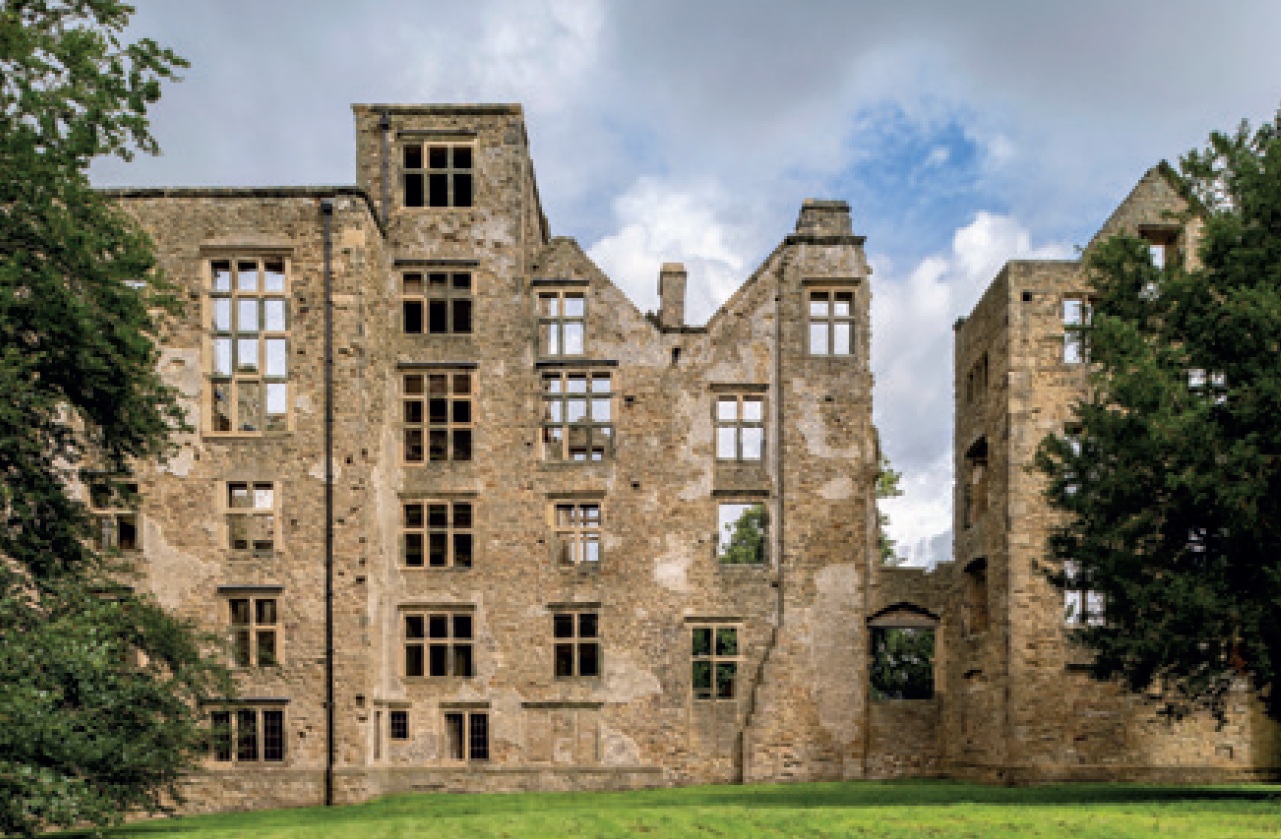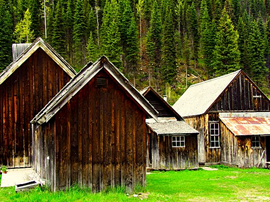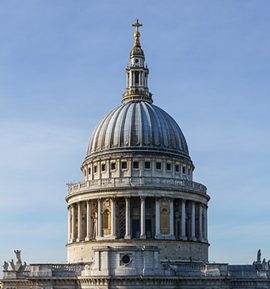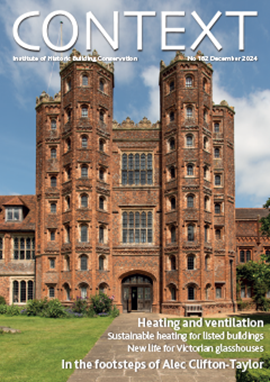Hardwick Old Hall, Derbyshire
Conserving the ruins of a great Elizabethan country house and facing the challenge of stabilising features, once in the interior, that are now exposed to the weather.

|
| Hardwick Old Hall, Derbyshire. A roofless ruin, exposed to the weather, where the main source of decay is wind-driven rain. |
Hardwick Old Hall, a great Elizabethan country house largely constructed between 1587 and 1597, stands as a romantic ruin. It is Grade I listed and a scheduled monument. At the time of the project it was under the guardianship of English Heritage within the National Trust owned estate of Hardwick. Old Hall is associated with one of the most influential women of her time, Elizabeth Shrewsbury, or Bess of Hardwick as she is better known. Old Hall’s age, form, architectural details, surviving and decorative scheme all contribute to its value. It gives a rare insight into general building design and construction in the 16th century and, more specifically, it tells us a great deal about the construction techniques and formulation of design ideas used on the adjacent, and slightly more modern, Hardwick Hall (1590–1597).
The Hardwick family had been established at Hardwick since at least the end of the 14th century, and Hardwick Old Hall incorporates fragments of an earlier house built by the Hardwicks on the site. Bess of Hardwick (1521–1608) bought the house in 1583 when her brother James, the former owner, died. Bess completely redesigned and greatly enlarged the existing house between 1587 and 1597. Bess’s husband (George Talbot, one of the richest men in the country) died in 1590 and with her inheritance Bess decided to build a new house, Hardwick Hall, right next to Old Hall, between 1590 and 1597. During the construction of the ‘New’ Hall, Bess continued to live in Old Hall. When she eventually moved into her new house Old Hall continued to be used for staff and guests for a number of years, with the two buildings forming part of one household.
In the 1750s, Old Hall was partly dismantled to provide stone for Chatsworth House. The west wing continued to be lived in until at least the end of the 18th century. During the 19th century the building deteriorated following further lead and stone removal. In 1912 the SPAB carried out extensive conservation works on the site. In 1956 internal floors were removed. The estate was transferred to the National Trust in 1959. English Heritage (then the Ministry of Works) took up guardianship of Old Hall, and carried out significant repairs and interventions each decade until the 1990s. This has left an interesting record of the evolving conservation techniques, from the SPAB in 1912 and the Ministry of Works in the 1960s, 1970–80, 1990s and 2000s, which all contribute to the building’s rich significance.
The most remarkable aspect of the Old Hall building is perhaps that although it is open to the elements, much of the original decorative plasterwork scheme, including a large number of highly elaborate overmantels, survives in situ. This effectively provides an open-air museum to the construction techniques and decorative schemes of the late-16th century and allows a unique insight into the likely construction of the neighbouring Hardwick Hall. Large patches of the original render, which once covered the external elevations of Old Hall, also survive. Not only is this unusual, but it also provided key evidence as to how the building was protected and presented.
Donald Insall Associates was appointed in 2020 to carry out a feasibility study for the repair and, if appropriate, sensitive alteration to reduce the frequency of repeat conservation works, under the English Heritage Sustainable Conservation Strategy and Asset Management Plan (SCAMP) principles. A detailed review of the recurring and cyclical repairs identified within the previous reports and building analysis, and gathering of the available intelligence from English Heritage maintenance and site staff who had first-hand experience of the building, was carried out. The first action on site was to complete a full-building, touching-distance condition survey.
The survey found:
- Accelerated stone decay caused by a soft sandstone becoming exposed to the elements after the lime render had fallen away. In many instances the stones had also been bedded in the wrong orientation.
- Failed mortar caused by age and later cementitious repointing.
- Concrete interventions (cast in situ replacement lintels, stair treads) with rusting metal rebar forcing fragments of concrete to fracture and fall from the mid-century repairs.
- Decaying structural timbers (floor beams and window lintels) which would have originally been internal but are now exposed to the weather.
- Failing decorative plaster, formerly internal but now exposed to the elements.
- Failing lime-ash/gypsum floors which are suffering from movement caused by their supporting timber structure decaying.
- Nesting birds have reached very high numbers, causing extensive debris from nesting materials and dislodging loose masonry.
- Saturated ground within the internal ground floor rooms due to the lack of a roof, presence of bedrock and lack of drainage from within the solid masonry perimeter walls.
These discoveries were followed by specialist investigations and reports, such as mortar, plaster, render and stone analysis; micro-drilling of the timber elements; and concrete carbonisation tests. Using the costed condition survey, the team converted its survey drawings into detailed repair proposals. It prioritised works that would arrest decay mechanisms, such as the replacement of failed cornices and hoodmoulds to shed water away from the elevation of the building. To complement the condition survey, it produced a set of outline proposals for more substantial future interventions. These included reroofing the most significant parts of Old Hall, or installing a temporary roof that could be deployed or retracted depending on the weather, with chainmail window coverings that could be removed in the summer but installed in the winter to keep out driving rain.
Because the building is now a roofless ruin on the top of a hill exposed to the weather, the main source of decay is wind-driven rain. Almost every square inch of the fabric provided a range of justifiable repair approaches. The team assessed each repair knowing that a strict budget of around £1 million had been set.
Along with replacement of the most decayed walling stones and repointing with hot-mixed lime mortar, the most significant interventions were the reintroduction of external lime render (or harl) to the west elevation; new enlarged lead canopies over the decorative plaster; renewal of the 1990s public viewing platform; extensive replacement of window mullions, jambs and transoms; and specialist conservation of the decorative plaster overmantels.
The most radical conservation technique employed was the reinstatement of the external lime render to the west elevation of Old Hall. The west elevation, sitting high on the cliff edge, is fully exposed to the prevailing weather. The original lime render had largely fallen away long ago, although numerous patches of the basecoat survived in situ. The now exposed soft sandstone has significantly eroded to the extent that the internal chimney flues have become exposed in places. This 20-metre wall also provides the backing substrate for the most significant of the decorative plaster reliefs: Gog and Magog within the Hill Great Chamber. This had been subject to continual moisture movement through the external masonry wall and subject to structural movement undermining the key between the plaster and sandstone.
Reinstatement of the lime render was preceded by structural repairs to the wall by rebuilding voids and replacing heavily eroded stones with new and dubbing-out of the deeper undulations. Primarily providing a protective coating over the masonry, the second beneficial aspect of the render is that it will encourage rainwater to spread around the more porous lime over the surface of the building, rather than penetrating into the stone structure behind. The original external lime render was analysed, and the proposed lime render mix was formulated to match the existing as closely as possible with a limewash finish. The new lime render does not try to recreate the original smooth-coated finish; the technical performance was prioritised over any goals of authentic reinstatement. It was agreed to apply a harl (thrown application to achieve a rough cast appearance).
This decision was taken for a few reasons:
- The new harl remains visually similar but subservient to the historic fragments of original plaster which had lost their outer coat layers.
- It differed aesthetically from the low-level fragments of internal plaster that remained on the west elevation where structures had been removed historically from the base of the wall.
- It allowed for a greater surface area to encourage faster evaporation of rainwater.
- It kept the additional weight of the intervention to a minimum on the historic structure.
The conservation philosophy for the project aligned with best-practice SPAB principles for sensitive repair. However, the SCAMP principles led to interventions being prioritised at a higher level over the low-level repetitive activities. For example, defrassing, pinning, indents or full replacement were favoured for any failing stone to ensure longevity, and mortar repairs were avoided. Historic SPAB repairs were retained where possible and new clay tiles repairs were minimised, with preference for stone replacement. This was so it would not confuse the evidence of the 1912 SPAB repair works and not to set a precedent for large areas of the building becoming terracotta rather than stone. The site reopened to the public in August.
This article originally appeared in the Institute of Historic Building Conservation’s (IHBC’s) Context 180, published in June 2024. It was written by: Dorian Proudfoot, a conservation accredited architect and director of Donald Insall Associates, who has been a lead consultant at Wentworth Woodhouse and Hardwick Old Hall, and Tom Bromet, an associate at Donald Insall Associates with an interest in cultural continuity through adaptive reuse and new build.
--Institute of Historic Building Conservation
Related articles on Designing Buildings Conservation.
- Archaeology and construction.
- Conservation.
- Don't take British stone for granted.
- Fires in historic buildings - the importance of emergency planning.
- Heritage.
- Historic environment.
- IHBC articles.
- Institute of Historic Building Conservation.
- SPAB.
- Specifications for Building Conservation - Volume 1: External Structure.
IHBC NewsBlog
SAVE celebrates 50 years of campaigning 1975-2025
SAVE Britain’s Heritage has announced events across the country to celebrate bringing new life to remarkable buildings.
IHBC Annual School 2025 - Shrewsbury 12-14 June
Themed Heritage in Context – Value: Plan: Change, join in-person or online.
200th Anniversary Celebration of the Modern Railway Planned
The Stockton & Darlington Railway opened on September 27, 1825.
Competence Framework Launched for Sustainability in the Built Environment
The Construction Industry Council (CIC) and the Edge have jointly published the framework.
Historic England Launches Wellbeing Strategy for Heritage
Whether through visiting, volunteering, learning or creative practice, engaging with heritage can strengthen confidence, resilience, hope and social connections.
National Trust for Canada’s Review of 2024
Great Saves & Worst Losses Highlighted
IHBC's SelfStarter Website Undergoes Refresh
New updates and resources for emerging conservation professionals.
‘Behind the Scenes’ podcast on St. Pauls Cathedral Published
Experience the inside track on one of the world’s best known places of worship and visitor attractions.
National Audit Office (NAO) says Government building maintenance backlog is at least £49 billion
The public spending watchdog will need to consider the best way to manage its assets to bring property condition to a satisfactory level.
IHBC Publishes C182 focused on Heating and Ventilation
The latest issue of Context explores sustainable heating for listed buildings and more.
















